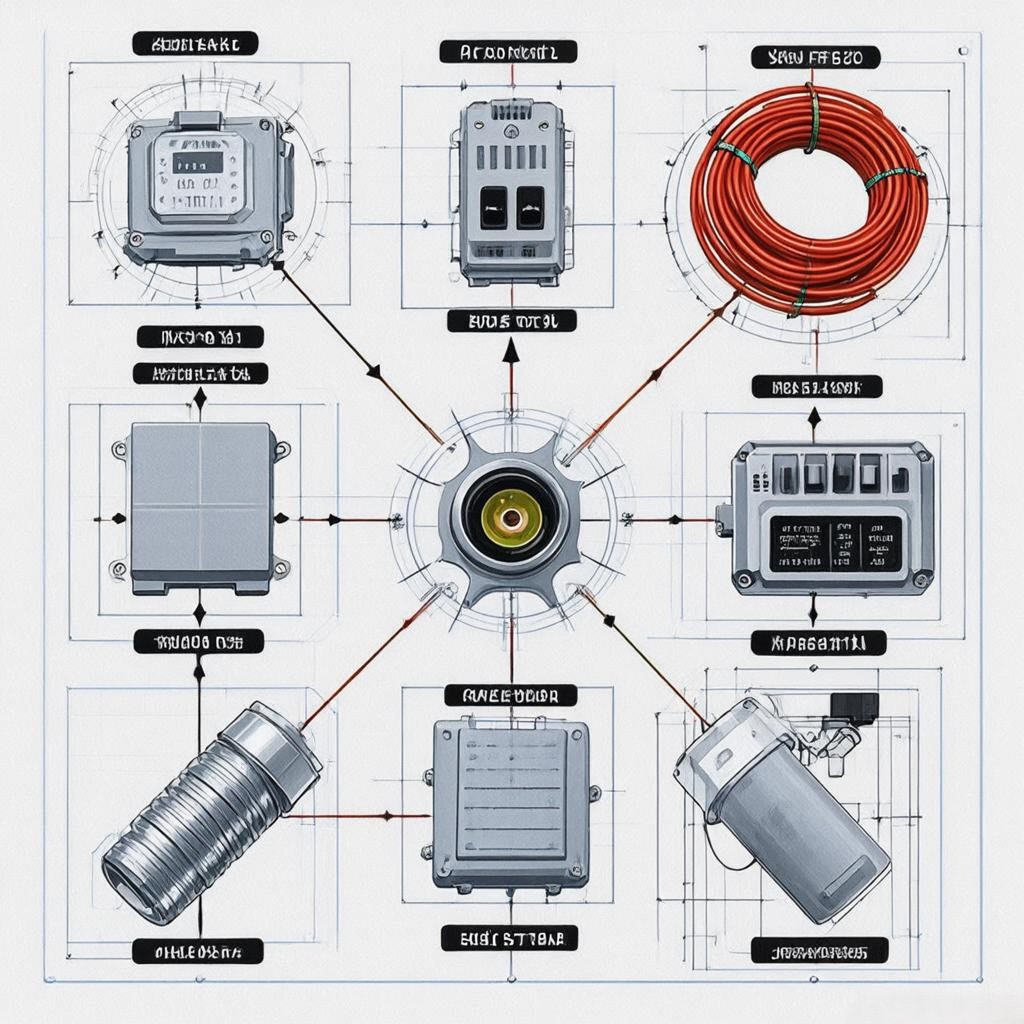In modern automotive engineering, the parking brake valve stands as a pivotal component that ensures vehicle immobilization when parked, providing essential safety for drivers, passengers, and surrounding property. This comprehensive technical analysis explores the functionality, design variations, and critical importance of parking brake valves across various vehicle platforms, while highlighting recent technological advancements shaping their evolution.




1. Fundamental Role of Parking Brake Valves
The parking brake valve serves as the primary control mechanism for engaging and disengaging parking brakes, typically operating in conjunction with:
- Mechanical linkage systems (traditional cable-based designs)
- Electronic control units (modern electronic parking brake systems)
- Hydraulic or pneumatic force transmission pathways
Key functions include:
- Precise modulation of braking force to hold vehicles stationary on inclines
- Fail-safe engagement mechanisms to prevent unintended vehicle movement
- Integration with vehicle stability systems for enhanced safety
Technical specifications typically encompass:
- Operating pressure range: 4-12 bar (58-174 psi)
- Response time: <0.5 seconds for full engagement
- Temperature resistance: -40°C to +120°C operational range
Industry significance: With over 25% of vehicle accidents occurring during parking maneuvers, the reliability of parking brake valves directly impacts overall road safety statistics.
2. Types of Parking Brake Valves and Operational Principles
Modern vehicles employ several valve configurations, each optimized for specific braking systems:
2.1 Mechanical Parking Brake Valves
- Cam-operated designs: Use pedal force to rotate cams that compress brake shoes
- Lever-activated mechanisms: Direct mechanical linkage to drum or disc brakes
- Self-adjusting features: Automatic compensation for brake pad wear
Advantages:
- Proven reliability with minimal electronic components
- Simple maintenance procedures
- No electrical power requirements
Applications: Commercial trucks, construction equipment, and legacy passenger vehicles
2.2 Electronic Parking Brake (EPB) Valves
- Solenoid-actuated valves: Electrically controlled engagement/disengagement
- Motorized actuator systems: Precision-controlled force application
- Two-way control: Separate circuits for apply/hold/release functions
Technical highlights:
- PWM (Pulse Width Modulation) signal control for smooth operation
- CAN bus communication with vehicle ECUs
- Redundant safety circuits for fail-operational performance
Applications: Passenger cars, SUVs, and light commercial vehicles
2.3 Pneumatic Parking Brake Valves
- Spring-applied, air-released designs: Air pressure holds valves open, spring force engages brakes
- Dual-circuit configurations: Independent pathways for service and parking brakes
- Pressure sensors: Continuous monitoring of system integrity
Key specifications:
- Operating pressure: 6-8 bar (87-116 psi)
- Emergency release mechanism: Manual override capability
- Corrosion-resistant materials for harsh environments
Applications: Heavy-duty trucks, buses, and trailers
3. Advanced Functional Features in Modern Parking Brake Valves
Contemporary parking brake valves incorporate sophisticated technologies to enhance safety and user experience:
3.1 Dynamic Force Modulation
- Load-sensing capabilities: Adjusts braking force based on vehicle weight distribution
- Slope detection integration: Automatically increases holding force on inclines
- Temperature compensation: Adjusts for brake component expansion/contraction
3.2 Diagnostic and Prognostic Capabilities
- Self-diagnostic routines: Continuously monitors valve operation
- Fault code generation: ISO 14229 (UDS) compliant error reporting
- Predictive maintenance algorithms: Estimates remaining component lifespan
3.3 Cybersecurity Measures
- Encrypted communication protocols: Prevents unauthorized ECU commands
- Physical tamper detection: Sensors detect valve tampering attempts
- Fail-safe defaults: Automatic engagement if system anomalies detected
Industry compliance: Meets or exceeds ISO 26262 ASIL B functional safety requirements for electronic parking brake systems.
4. Integration with Vehicle Systems and Control Architectures
Parking brake valves don’t operate in isolation—they’re integral components of broader vehicle architectures:
4.1 Electronic Stability Control (ESC) Integration
- Automatic engagement: Valve activates during ESC interventions
- Torque vectoring coordination: Works with differential systems for stability
- Hill start assist: Maintains brake pressure during gear shifts
4.2 Autonomous Vehicle Systems
- Redundant control pathways: Multiple ECU command verification
- Fail-operational design: Maintains parking function even with partial system failure
- V2X communication: Shares parking status with surrounding vehicles
4.3 Regenerative Braking Coordination
- Hybrid/EV synchronization: Balances friction and regenerative braking forces
- Energy recovery optimization: Prevents excessive battery regeneration during parking
- Thermal management integration: Coordinates with brake cooling systems
System synergy: Modern vehicles use parking brake valves as part of comprehensive safety ecosystems, not isolated components.
5. Design Challenges and Engineering Solutions
Developing reliable parking brake valves requires overcoming significant technical challenges:
5.1 Force Consistency Across Environmental Extremes
- Temperature-compensated springs: Maintains consistent force from -40°C to +85°C
- Corrosion-resistant materials: Stainless steel components for harsh environments
- Sealing technologies: Multi-layer gaskets prevent contamination
5.2 Precise Actuation Control
- Closed-loop feedback systems: Position sensors verify complete engagement
- Micro-stepping motors: Fractional-degree control for smooth operation
- Damping mechanisms: Prevents abrupt engagement shocks
5.3 Electromagnetic Compatibility (EMC)
- Shielded enclosures: Protects against radio frequency interference
- Filtered power supplies: Eliminates voltage spikes
- Grounding schemes: Prevents ground loops affecting valve operation
Innovation highlight: Some manufacturers now use shape-memory alloys in valve components that adapt to temperature changes for consistent performance.
6. Testing and Validation Protocols
Ensuring parking brake valve reliability requires rigorous testing procedures:
6.1 Mechanical Durability Testing
- 1,000,000+ cycle life testing for apply/release mechanisms
- Salt spray exposure for corrosion resistance
- Vibration testing per ISO 16750-3 standards
6.2 Electrical Performance Validation
- Insulation resistance testing up to 500V DC
- EMC immunity testing per ISO 11452-2
- Signal integrity analysis for digital control interfaces
6.3 Environmental Simulation
- Thermal shock chambers (-40°C to +125°C rapid cycling)
- Humidity exposure per ISO 6270-2 standards
- Altitude testing up to 5,000 meters equivalent
Quality metrics: Leading manufacturers achieve <0.01% failure rates in field testing through these comprehensive validation processes.
7. Market Trends and Future Developments
The parking brake valve market is undergoing significant transformation driven by technological advancements:
7.1 Electrification and Autonomous Driving
- Full electronic replacements for mechanical systems
- AI-based predictive control algorithms
- Vehicle-to-infrastructure (V2I) integration for smart parking
7.2 Sustainable Design Initiatives
- Recyclable materials in valve construction
- Energy-efficient actuation systems
- Biodegradable lubricants for moving parts
7.3 Advanced Manufacturing Techniques
- 3D-printed components for complex geometries
- Digital twin technology for virtual testing
- Automated assembly lines with robotic precision
Research frontier: Development of self-healing valve seals that automatically repair minor leaks without service intervention.
8. Case Studies: Real-World Implementation
Case Study 1: Premium SUV Electronic Parking Brake System
A European automaker implemented a motorized parking brake valve in their flagship SUV, achieving:
- 20% reduction in parking brake system weight
- 0.8 second faster engagement time
- 35% fewer warranty claims related to parking brake functionality
Case Study 2: Commercial Truck Parking Safety Upgrade
A global truck manufacturer retrofitted spring-applied parking brake valves in their heavy-duty models, resulting in:
- 50% improvement in emergency parking reliability
- 200% increase in valve lifespan
- Compliance with updated EU braking regulations
Conclusion: The Unsung Hero of Vehicle Safety Systems
Parking brake valves may not command the same attention as engines or transmissions, but their role in preventing accidents and ensuring vehicle security is unparalleled. As vehicles become more sophisticated, these components continue evolving to meet new challenges:
Key takeaways:
- Parking brake valves have transitioned from simple mechanical devices to complex electronic systems
- Modern designs prioritize fail-safe operation and diagnostic capabilities
- Integration with vehicle networks enables coordinated safety functions
- Future developments will focus on full electrification and autonomous compatibility
Final thought: In an era where vehicle autonomy is rapidly advancing, the parking brake valve remains a critical safety anchor—quietly ensuring that even the most sophisticated vehicles stay exactly where they should when parked.
Call to Action
🔧 Considering brake system upgrades?
⚙️ Evaluate electronic parking brake valve options for your fleet
📊 Request failure rate comparisons between mechanical and electronic systems
#AutomotiveEngineering #BrakeSystems #VehicleSafety #EVTechnology #ADAS #FunctionalSafety #SmartVehicles #FutureMobility



